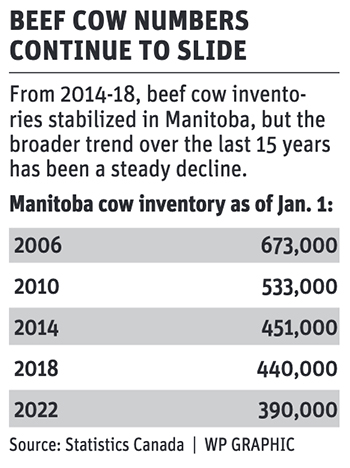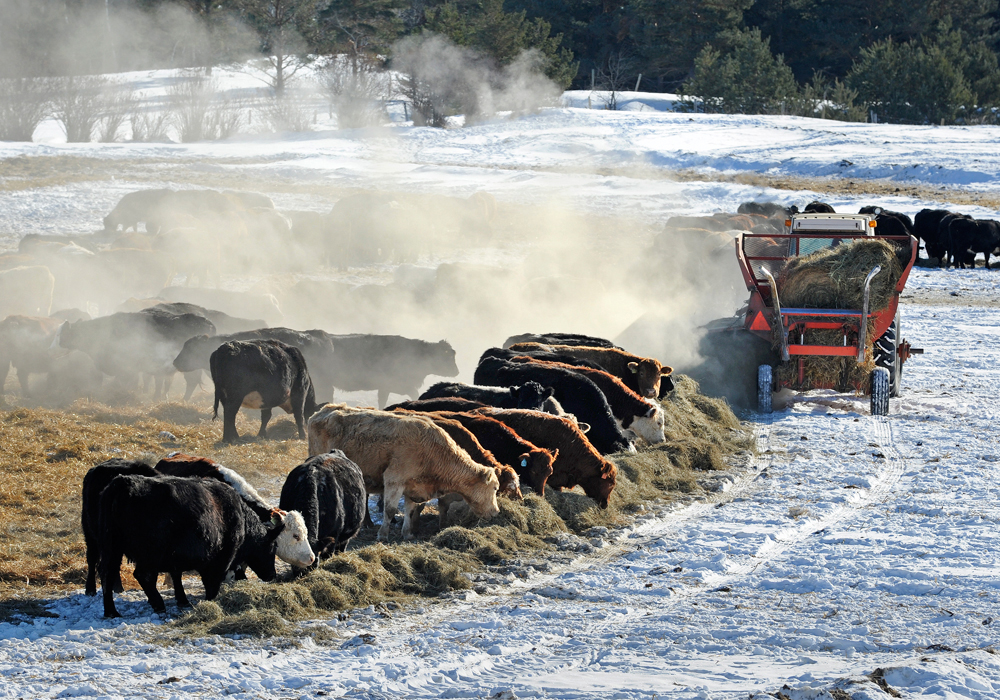Industry says many producers decided to get out of the business after last spring’s snowstorms played havoc with calving
Statistics Canada data for cattle inventories as of Jan. 1 will not come out until later this month, but the size of Manitoba’s cattle herd and the number of cow-calf operators took a substantial hit in 2022.
A Manitoba Agriculture report on how the 2021 drought affected the provincial cattle sector, released in late January, shows that the number of beef cattle in the province declined by 78,000 last year. That’s a 7.7 percent drop from beef cattle numbers in 2021.
The Manitoba Agriculture report is as follows:
- In 2021, there were 1.006 million cattle on beef operations in Manitoba.
- By 2022, that figure was 928,500.
- The number of cattle in feeder operations increased slightly, going from 66,000 to 70,000.
- The decline happened almost entirely in cow-calf operations. The inventory went from 788,000 cattle in 2021 to 717,000 in 2022, a drop of nine percent.
The Manitoba Agriculture report was based on Statistics Canada inventories from July 1, 2022.
It’s possible that Manitoba’s beef inventory will be even lower as of Jan. 1, 2023, because some producers reduced their herd size or quit the business in the fall.
Tyler Fulton, Manitoba Beef Producers president, said ranchers cut back or quit cattle for many reasons.
Ongoing impacts from the severe drought of 2021, the brutal winter of 2021-22, producers getting older and weak cattle prices relative to crop prices are all on that list.
But for many producers, three spring snowstorms in 2022 may have been the deciding factor.
“I actually think, and I’ve heard it time and again, that the spring storms of last year was truly a (massive issue),” Fulton said at the MBP annual general meeting, held in Winnipeg Feb. 2-3.
“The terrible spring calving season that we had last year, that resulted in death loss that was unmatched in recent times…. It was as if that was the last straw.”
Bill Campbell was one of the many farmers who sold his cattle herd in 2022.
Campbell ran a mixed farm for decades near Minto, Man., but last fall he liquidated his entire herd.
He cited several reasons for getting out of the cattle business: the weather last spring, wanting to spend more time with his family and an employee who was no longer available to work.
The largest factor was timing.
He wanted to stop before declining health forced him to stop.
“I spent more time with my cows than my kids,” he said at the MBP meeting. “It was tough. But you get to a certain point in your life where decisions need to be made.”
Other Manitoba ranchers took a different approach. They’re still in the cattle business, but they cut their herd size in 2022.
“I saw a lot of herd dispersals that were about reducing the size of their herds to match the portion of their land that they couldn’t utilize in other ways,” said Fulton, who farms near Birtle, Man.
In other words, if a producer had a half-section of forage land that could be used to grow canola, they may have switched the 320 acres to crop production.
“When there is $22 (per bushel) canola staring you in the face and you know you are barely breaking even on your cow-calf operation, it’s pretty rational,” Fulton said.

It could take time for Manitoba to recover from the drop in cattle numbers, especially the cow numbers. However, Fulton and other beef producers are hopeful.
In a speech at the annual meeting, Fulton said current prices and futures prices are exceptional.
“We’ve got six-weight (600 pound) calves up over $3 per lb…. Most recently the livestock price insurance program staring offering coverage levels, for the fall, at $2.90,” he said.
“That represents $1,750 for a six-weight steer calf.”
Those prices have producers believing that money can be made in 2023, assuming the weather on the Prairies returns to something close to normal.
Manitoba Beef Producers holds a director meeting every month, which normally includes a report from representatives in each region of the province.
“It truly felt like we saw a trend change (in January). There was optimism around the table that there are profits to be had,” Fulton said.
“I think there’s a ton of room for optimism. The macro-fundamentals of the cattle market in North America are very supportive.”
The lower supply of cattle and strong prices should encourage expansion and new entrants in Manitoba, Fulton added.
















